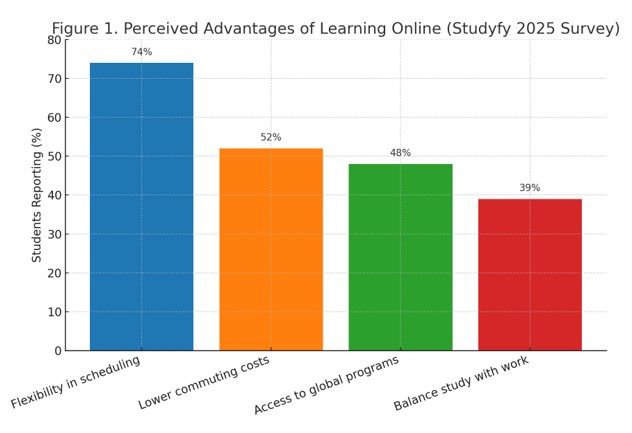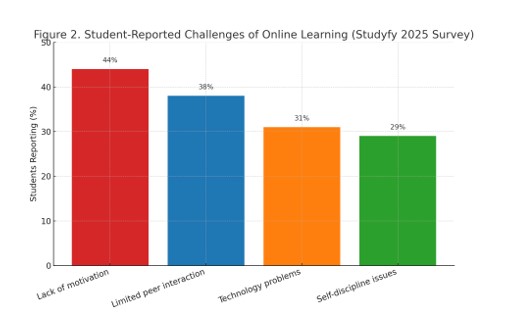Online education has moved from being a backup solution to becoming a cornerstone of modern learning. According to Studyfy's 2025 Global Education Survey, conducted with 3,400 students and 500 instructors across North America, Europe, and Asia, 72% of participants believe that online learning is the future of education.
Students adapting to this shift often seek additional support to manage workloads. Tools such as essay writing service online provide resources and models that help learners improve their writing while balancing busy schedules. These supports are not replacements for learning but complementary aids that strengthen student confidence in academic work.
The growth of online education
Over the past decade, digital platforms have transformed the education landscape. Studyfy's 2025 data shows that 65% of students now take at least one online class per semester, compared to just 23% in 2015.
Table 1. Student Enrollment in Online Courses (Studyfy 2015-2025 Survey)
|
Year |
% Students Enrolled in Online Classes |
|
2015 |
23% |
|
2020 |
41% |
|
2023 |
58% |
|
2025 |
65% |
This steady growth confirms that online education is becoming more and more popular, reshaping how institutions design programs and how students manage their studies.
Flexibility and convenience remain the strongest reasons why students choose digital platforms. Studyfy’s 2025 Global Education Survey asked learners to identify the most important benefits of online learning.
Figure 1. Perceived Advantages of Learning Online (Studyfy 2025 Survey):
- Flexibility in scheduling: 74%
- Lower commuting costs: 52%
- Wider access to global programs: 48%
- Ability to balance study with work: 39%

The results confirm that the advantages of learning online go beyond affordability. Students value freedom of time and access to institutions worldwide, showing why online education is becoming more and more popular year after year.
Key trends shaping the future
The technological trends in education point toward new tools and teaching strategies that make digital classrooms more effective.
Artificial intelligence and personalized learning
AI adapts coursework to student needs. Studyfy's 2025 instructor survey found that 61% of professors already use AI to provide personalized feedback. By analyzing student progress, AI platforms recommend targeted resources, enhancing retention and engagement.
Virtual and augmented reality
Virtual reality (VR) and augmented reality (AR) bring immersive experiences into the digital classroom. For example, a biology student can conduct a lab simulation, while a history student can explore a 3D reconstruction of ancient Rome. These experiences address the debate over whether online education is good or bad, showing that digital formats can be interactive and highly engaging.
Microlearning and bite-sized content
Attention spans are shrinking, and online education adapts with shorter, more digestible modules. Studyfy's 2025 data shows that 47% of students prefer microlearning formats over hour-long lectures. This supports emerging trends in education that focus on practical, applied knowledge delivered in smaller chunks.
The role of accessibility and inclusion
The important of online education is tied to how accessible it is. According to Studyfy's 2025 Accessibility Report, 42% of students with disabilities said online formats improved their ability to participate fully in higher education.
Table 2. Barriers to accessibility in online education (Studyfy 2025 survey)
|
Barrier |
% Students Reporting |
|
Limited internet access |
36% |
|
Lack of devices |
29% |
|
Poor platform usability |
22% |
While online platforms open doors, they must address gaps in access. Institutions that close these gaps will lead in shaping the future of online education.
Challenges in online education
Despite rapid growth, digital formats face challenges. Studyfy's 2025 Research revealed that 44% of students find it difficult to stay motivated in online courses.
Top challenges reported by students:
- Lack of motivation (44%).
- Limited peer interaction (38%).
- Technology problems (31%).
- Difficulty in self-discipline (29%).
Even as digital platforms grow in popularity, students face notable difficulties in adapting to them. Studyfy’s 2025 Research highlighted the most common barriers to effective online learning.
Figure 2. Student-Reported Challenges of Online Learning (Studyfy 2025 Survey):
- Motivation: 44%
- Peer Interaction: 38%
- Technology Issues: 31%
- Self-Discipline: 29%

These statistics highlight why many students combine online learning with structured support like writing workshops or writing service online platforms. Here, writing service online models can ease academic stress, especially during exam-heavy weeks, by providing examples and feedback.
Preparing students for the digital economy
Education does not end with the classroom. The future of online education must prepare learners for a workforce dominated by digital tools, remote collaboration, and constant adaptation.
How online education prepares students for careers
- Remote teamwork tools mirror global workplace practices.
- Exposure to diverse, international classrooms.
- Training in digital communication and virtual presentations.
- Adaptability through constant tech integration.
Studyfy's 2025 Workforce Readiness Survey found that 59% of employers value online learning experience because it signals adaptability - a critical skill in the digital economy.
Conclusion
The debate over whether online education is good or bad is shifting. With strong technological support, increased accessibility, and rising demand, the balance tips clearly toward opportunity. Still, addressing motivation, equity, and technical barriers remains essential.
The future of online education lies in blending personalized AI, immersive VR, and accessible design to create inclusive, effective classrooms. As online education is becoming more and more popular, it is no longer a secondary option but a primary mode of learning worldwide.
For students, tools such as Studyfy and institutional support systems will ensure they thrive in this evolving landscape. Ultimately, the question is not whether online learning is the future of education - it is how quickly students, educators, and institutions can adapt.
References
Digital Learning Institute. Education Technology Trends to Watch in 2025. https://www.digitallearninginstitute.com/blog/education-technology-trends-to-watch-in-2025
Educations.com. 5 Reasons Online Learning is the Future of Education. https://www.educations.com/articles-and-advice/5-reasons-online-learning-is-future-of-education-17146
Harvard Online. Shaping the Future of Online Learning. https://harvardonline.harvard.edu/blog/shaping-future-online-learning
OECD. Trends Shaping Education 2025. https://www.oecd.org/en/publications/2025/01/trends-shaping-education-2025_3069cbd2.html

